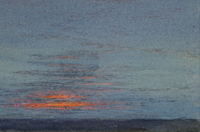Ruskin's Educational series, 1st ed. (1871)
Ruskin's first catalogue of 300 works for the instruction of undergraduates and his notes on the use of particular examples.

Ruskin's Introduction
The choice and arrangement of this Series have been determined with a view to two distinct ends; the first, to call your attention, by precision of copying, to the qualities of good Art; the second, to give you, yourselves,such power of delineation as may assist your memory of visible things, and enable you to explain them intelligibly to others. The first of these objects is, however, the primary one, and the more attainable. A short time earnestly spent in practical efforts will give you a basis of judgment in Art which cannot be afterwards disturbed, though protracted application will be necessary to enable you to draw in any wise rightly yourselves. But it isof greater importance that you should learn to distinguish what is entirely excellent, than to produce what is partially so.
There are now in your rooms twelve Cabinets of these examples, eachcontaining twenty-five drawings or engravings.
In the first of them are introductory subjects only; chiefly sketches of the flowers, or at least of the representatives of the tribes of flowers, which have had strongest influence on the human mind in all ages, and have become types of ideas which are always true, — always sources of innocent pleasure,— and therefore common to the religions of the East, of Greece, and of Christendom.
The second Cabinet contains such examples of Greek Architecture and simple design as will best enable you to discern the laws of practice under which the Hellenic nation bound themselves, or were, by their instincts, bound;and the strictness of which enabled them to lay the foundations of allsubsequent art, either existing, or conceivable.
The third Cabinet illustrates the course of the Arts in the north of Europe, from the development of their first perfect elementary school of round-arched architecture, to the consummate work of German artists in the sixteenth century.
The fourth Cabinet illustrates the Course of southern (that is to say,essentially of Italian) Art,from its first assertion of itself asa distinct style in the thirteenth century to its perfect results in the sixteenth.
The fifth and sixth Cabinets contain examples of the schools of landscape which were founded, first in Holland and then in England, on the fragmentary traditions of the figure-painting which ceased, as disciplined art, to exist after the seventeenth century: schools which in England have taken healthy root, and may, to yourselves,in early practice, be of greater use and interest than any others.
The seventh and eighth Cabinets contain illustrations of the treatment of Animal form by the higher methods of sculpture and painting.
These eight cabinets, then, give you in narrow epitome, a view of what has been done already, and may now be carried forward by your own influence, in art that is good for men. Only you are to note that the second group shows you, in Greek work, only the character of its laws, and nothing of its final achievement.
This is in order that you may not be confused by the sight of qualities which can in no wise be attained and imitated by yourselves. It is possible for you to feel, and therefore to draw, in some measure like a German, an Italian, or a Hollander. But it is absolutely impossible that you should ever feel,and therefore that you should ever draw, in the least like a Greek. Therefore I give all necessary illustrations of the higher art of Greece in the Standard Series, and purposely withdraw them from the Educational one. You can only understand them perfectly, by fully recognizing that you cannot imitate them.
On the other hand, you cannot fail to find, on thoughtful examination of the examples given in the third and following groups, (namely, from the elder German school, the elder Italian, and modern English school of landscape,)something which, if you have in yourselves any real liking for art, you will naturally wish, and may rationally hope, in some degree to imitate. Then inthe four Supplementary Cabinets, distinguished from the others by reference to consecutive letters instead of numbers, there are instances of the best modes of execution employed in these great systems of work, and adapted for your own practice. I distinguish them by another notation, because many of the photographs and engravings in the first eight Cabinets are for your study only, not for copying; but all in the lettered series are intended for exact guidance in practice. Some few changes have yet to be made before the arrangement of these twelve Cabinets can be completed; I must myself make several more careful drawingsto take the place of hurried ones;and, especially in the supplementary examples of rock and tree drawing, some of the engravings will be ultimately changed, or have drawings put in their place. But the number of this Educational Series will not be increased. It will consist always of three hundred pieces, as it does now; it will beslightly modified only in detail; not at all in form; and will remain afterwards undisturbed in the Upper School.
The Reference Series, on the contrary (marked R, on the frames containing it), will belong to the Lower School, and will contain rudimentary exercises; and whatever I find necessary for future work of a general character. I now catalogue the pieces belonging to the Educational Series shortly and clearly, without breaking their order by any comment. At the end of the list of them you will find notes on the use of particular examples.




